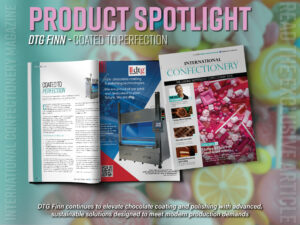Extrusion and forming are vital stages in the gummy production process, thus this feature investigates the processes involved and popular extrusion/forming machines.
The gummy industry especially sees this huge necessity for an array of high-tech equipment that will allow the gummies to have their unique look and feel. This is because the gummy sector with a major market, as it has been reported in a Market Analysis report that, “The global gummy market size was valued at USD 16.28 billion in 2020 and is expected to grow at a compound annual growth rate (CAGR) of 12.6% from 2020 to 2028.” We have briefly touched upon in other features in this edition the various machines used to cook and deposit gummies to get their distinctive texture and flavour. However, one of the most important features in the production of gummies is the extruding and forming process. These steps are vital in creating the shape, style and look of a gummy product which can make the sweet item iconic to a certain brand. With that being said, it is time to assess what the extruding and forming process is, the machinery innovations, and benefits of using this type of machinery in gummy production.
What is extruding and forming and the processes
The extruding and forming processes are the methods that create the shaping and design of the gummy. Extrusion technology can simply be defined as an automatic machine that forms bars or lines of product mass. This can range from anything such as cereal, candy, fruits, and proteins. In the gummy sector, the extrusion machine presses out the gummy mass, that has been cooked and deposited, through forming nozzles and makes interminable product lines, then the line is cut into specific length. The gummy line is usually cut by a water lubricated blade that is built into the production line. Haribo tend to cut their liquorice gummies into 18cm and 21 cm lengths the water also rinses of any liquorice built up on the blade. After this the gummies are placed onto an aluminum rack, and they are then left in an oven to remove any further excess moisture.
After about 8 hours, the gummies are then removed and packaged. The oven processing method will again vary depending on the type of gummy being created and the type of manufacturer that is using the production line. They are integral in shaping the gummies by adding twists, stripes, varying colours and more. An extruder can also be equipped with a Filling feedings station that allows fillings to be added inside any potential gummy treat. Further into a confectionery context, the extruder systems work by forcing cooked masses through a dye into a desired shape. Companies such as VIVAPIGMENTS, Capol use this type of extrusion process for their candies with Plamen Nikolov, Director of Research & Innovation and Alberto Sarti, Sales Manager at VIVAPIGMENTS commenting how, “[they] obtain VIVAPIGMENTS by an encapsulation of a natural dye and it is soluble, and then we make the colour by extrusion, so with this micro encapsulation the pigment becomes very dispersible in fat based or sugar-based products,” proving that it is a very common method in the candy production sector.
Read more of this article here: February 2022 Single Issue form – International Confectionery Magazine (in-confectionery.com)
Media contact
Roshini Bains,
Editor, International Confectionery
Tel: +44 (0) 1622 823 922
Email: [email protected]









